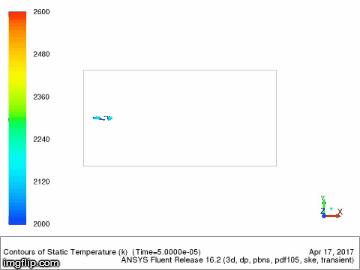-
-
November 13, 2018 at 7:39 am
anilwakale
SubscriberDear all,
Is anyone working on the Vapor pressure model using UNIFAQ method UDF from Properties of GAS and Liquids by B.E. Poling
As we all know during combustion the Vapor pressure of liquids will vary with temperature and it should be accurately entered in CFD simulations at least until critical temp and pressure of the liquid. I am working on both Spray simulation using Steady flamelet model and details you can see my previous blogs. I want to know the vapor pressure at every time step or at with increment of 30-50 in both spray simulation as well as diesel unsteady model for Compression ignition engine.
And another question regarding Droplet injection methods
is it DPM and Multicomponent will work similar in Fluent of not
As we can see In both cases of Droplet and the multicomponent method I need to change The value of KH-RT constat CL from 25 to 22 for droplet to multicomponent to match ECN Spray-A validation.
-
November 13, 2018 at 7:50 am
Amine Ben Hadj Ali
Ansys EmployeeThe only difference which comes to my mind is the interpretation of boiling mode: For droplet the boiling temperature is used whereas for multi-component the sum of saturation pressure of each components is used (compared to surrounding).
-
November 13, 2018 at 9:26 am
anilwakale
SubscriberBut then is it valid to change the KH-RT constants as per the methods (in order to match expe. results )
Because in droplet method, I am simulating the total of 1mole (n-dodecane) and for the same case in Multicomponent we are giving 0.999999mole of (n-dodecane) and 1e-6 mole of (ethanol or any alternative fuel ). In the next cases, we want to study the effect of various fuel blends (methanol, ethanol and n-butanol in 5,10,20,40% blending ) with diesel (n-dodecane). For all these cases we want to use the Multicomponent method and we will not change the KH-RT constants.
-
November 13, 2018 at 10:01 am
Amine Ben Hadj Ali
Ansys EmployeeThe Levich constant Cl is adjustable and might be related to the cross-sectional area of the contracted liquid jet or just to B1.
-
November 13, 2018 at 11:11 am
anilwakale
SubscriberThat's Helpful for me but again I will go back to my original question
can we find the Vapor pressure data as output file from Fluent?
-
November 13, 2018 at 12:09 pm
Amine Ben Hadj Ali
Ansys EmployeeThere are some default for some materials like for water with 32 points (data here is from NIST). Is you material a default one?
-
November 13, 2018 at 5:14 pm
anilwakale
SubscriberNo. Mine material is not default. Ansys Fluent don't have properties of n-butanol and n-dodecane. I will be happy if fluent database increase to at least to c12-16 higher hydrocarbons and alcohols like (n-butanol, Biodiesel, DME, DEE if possible)
I am manually entering the value for other fuels (n-dodecane/butanol) but at blends, our mixture fraction should vary and that's why we are giving UDF to saturation vapor pressure data by UNIFAQ method from the book Not only for this but for rest properties to Cp, viscosity, surface tension. Additionally, we want to vary latent heat too but the option was not available. we compared our all data points with NIST std values with less than 6 to 8% we are maintaining all the thermo property values
I want to share an animation of spray combustion and want to ask some question too if you permit
-
November 13, 2018 at 5:31 pm
Amine Ben Hadj Ali
Ansys EmployeeSo you are providing the saturation property and other materials via DEFINE_DPM_PROPERTRY. There is not a way to plot that in Fluent. Regarding material properties, it is worth mentioning that we all CHEMKIN power in our portfolio. Saying that one can find for many fuels suitable descriptions.
As ANSYS Stuff I cannot answer outside of this community..
-
November 13, 2018 at 5:36 pm
anilwakale
SubscriberExactly and we modified some code DEFINE_DPM_PROPERTRY .
Completely agree with you
I will share my spray animation soon and the question also
-
November 14, 2018 at 4:04 am
anilwakale
Subscriber
If you see the Time is 5e-5 and my starting time itself was 1e-6 and I plotted with 2000-2600 temp range
so in this gif. we are not getting any ignition delay. using Steady diffusion flamelet model. I have to simulate the same case as given below (link)
https://www.youtube.com/watch?v=b6wfODEp0VE
Not with LES but with RANS using Fluent. We are getting above lift of length for non-reacting spray but in reacting our spray will start combusting as soon it enters into the chamber. In the link above its clear that spray will come in liquid form enters into the hot environment and with some Ignition delay spray starts combusting. Do you suggest any tutorial for it? Initial conditions of the chamber are mimic of ECN spray A expe. (Pin=61MPA, Tin=900K, fuel Temp=363K and rest all BC)
-
November 14, 2018 at 9:10 am
Amine Ben Hadj Ali
Ansys EmployeeI recommend using LES and detailed reaction mechanism with EDC or FGM.
For the ignition delay you can check if one of the methods in Fluent are suitable or not.
-
- The topic ‘Vapor Pressure calculation’ is closed to new replies.


- air flow in and out of computer case
- Varying Bond model parameters to mimic soil particle cohesion/stiction
- Eroded Mass due to Erosion of Soil Particles by Fluids
- I am doing a corona simulation. But particles are not spreading.
- Centrifugal Fan Analysis for Determination of Characteristic Curve
- Issue to compile a UDF in ANSYS Fluent
- Guidance needed for Conjugate Heat Transfer Analysis for a 3s3p Li-ion Battery
- JACOBI Convergence Issue in ANSYS AQWA
- affinity not set
- Resuming SAG Mill Simulation with New Particle Batch in Rocky

-
4167
-
1487
-
1363
-
1194
-
1021

© 2025 Copyright ANSYS, Inc. All rights reserved.









